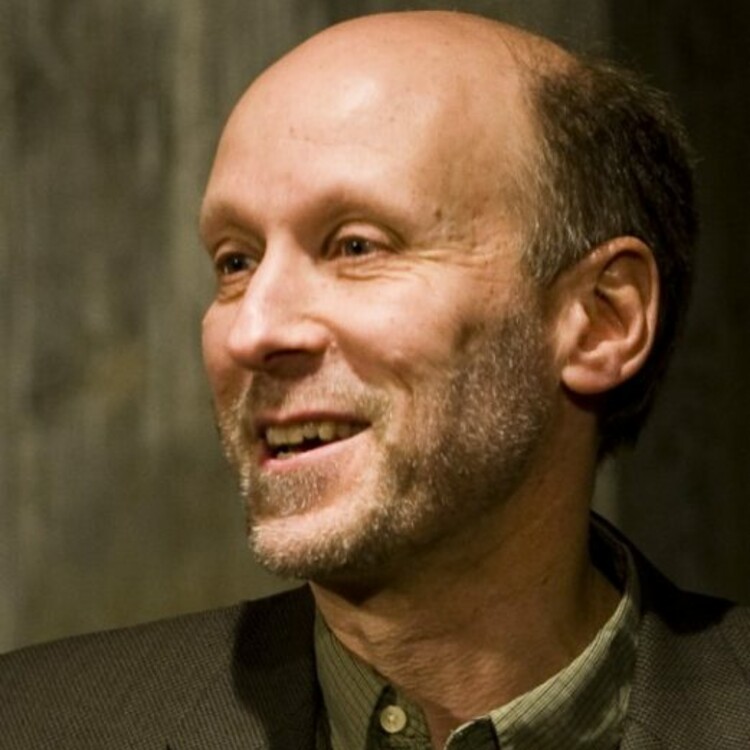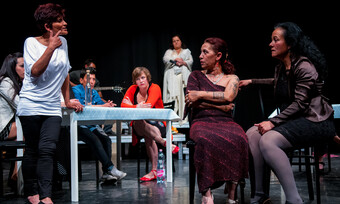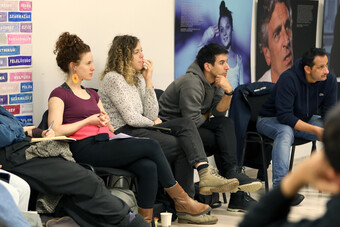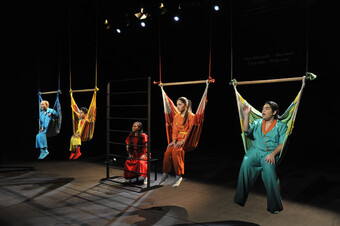Our visit to Budapest took place at a disturbing moment for the theatre community. On 8 November, just prior to our arrival, the State Secretary for Culture had announced that one of the main funding sources for theatre—a corporate tax scheme that matched up to 80 percent of all box office revenues and had been in place since the previous liberal/socialist government—would be discontinued due to corruption, and a new scheme would be announced in its place. To date, no new scheme has been announced. According to one theatre academic we spoke with, this is consistent with Fidesz’s overall strategy “to try to blur all the existing ways of managing the system. They’re not reforming it, just purposely demolishing it so no one really knows what’s going on. This creates a healthy situation for the spider in the middle of the web.”
The ideological goal of this approach becomes clear against the larger political backdrop, which has seen, under Fidesz control, the nationalization of over 80 percent of all Hungarian media outlets, the replacement of most of the provincial theatre directors with party-affiliated artists, and the replacement of Róbert Alföldi as director of the National Theatre in 2013 with Attila Vidnyánszky, who has eliminated nearly all topical and contemporary content in favor of Hungarian and world classics. In the process, Vidnyánszky has ingratiated himself with the government and emerged as virtually the only artist who influences national cultural policy—and this is in a system where theatres are exclusively dependent on local and national government funding for both operating and programmatic support.
While no specific content restrictions on theatre are likely to be published, everyone seems to understand the government’s goals. Since their re-election last year, Fidesz has become more and more aggressive in enforcing their “Hungary First” slogan in all aspects of civic life. While aiming to engender pride in Hungarian history and culture, this in effect means, according to the academic we spoke with, “setting aside the more problematic aspects of Hungarian history, blaming others for the nation’s problems, and eliminating the need for self-criticism”.
At stake is not only whose work gets supported, but whether Hungarian culture will offer a full picture of the country’s complex history or, instead, reduce it to a set of celebratory high points.
Accordingly, public buildings and spaces are being renamed, a Hungarian Academy of Arts has been created to honor retired artists and support state-sponsored cultural projects, and millions of dollars are going into a new Hollywood-style epic film about the father of King Matthias from the fifteenth century. Huge sums are also being spent to tour traditional Hungarian opera and dance productions internationally, such as the recent four-million-dollar engagement at Lincoln Center involving 350 artists and crew. Meanwhile the more progressive independent theatres have smaller and smaller grants to pay artists, keep their productions on stage, and create new work. At stake is not only whose work gets supported, but whether Hungarian culture will offer a full picture of the country’s complex history or, instead, reduce it to a set of celebratory high points while darker episodes, such as Hungary’s role in the Holocaust, are systematically erased from the national consciousness.
In meetings Arnoult, Lawrence, and I had with nearly two dozen leading artistic directors, directors, actors, producers, critics, and academics, one point was reiterated over and over again: that the space for political action in relation to the government’s decisions has shrunk to nearly nothing. All decisions are made from the top down, and it’s simply a waiting game to see what actions the Orbán government takes. It appears certain that, even without official censorship, any new system of state subsidies will give the government even more control over the work that theatres put on their stages. As if to prove the point, the official Fidesz party newspaper, the Hungarian Times, has run a series of articles denouncing specific cultural institutions and artists.
We heard at least two recent examples of artistic directors being called in to meetings with low-level bureaucrats who expressed their displeasure with specific works. Naturally, the bureaucrats hadn’t actually seen the works in questions but had read about them in the party media. In such an environment, the most politically challenging work has become the most vulnerable, and already a number of leading independent companies have folded, including Krétakör, HOPPart, Barka Theatre, and Sputnik Shipping Company.
But there is good news. Some directors report that theatre has become an even more important lifeline for Budapest audiences, who remain enthusiastic about political pieces and, in the words of one leading director, “now want us to not only ask the relevant questions but also provide the answers.” Most theatres appear to be consistently full, despite the fact that over six hundred thousand of Hungary’s best-educated citizens have fled the country in the past few years (a trend that will only accelerate with the departure of the George Soros–funded Central European University, something that was announced during our trip).
And judging by the dozen-plus productions we saw, the relevance and artistic level of the work on Budapest’s stages remains high, driven first and foremost by the very muscular acting style that is characteristic of Hungarian theatre, by a repertory system that can keep shows playing and growing for ten years or more, and by the highly competitive training system that continues to funnel gifted newcomers into the profession. Among the classic works on stage were Friedrich Dürrenmatt’s Romulus the Great from 1949, which was given a fresh Hungarian spin at the tiny Studio K under the title Leapfrog. Howls of laughter greeted the contemporary references embedded in this comically absurd tale of the last emperor of Rome, who willingly allows his empire to fall to invaders so it can be cleansed. Equally timely was Róbert Alföldi’s lean and muscular production of Marlowe’s Edward II at the Átrium Theatre, with the doomed king depicted as an ironic and bitter man increasingly isolated by his homosexuality. (Just this past June, a production of Billy Elliot at the Hungarian State Opera was forced to close after a pro-government newspaper claimed it could influence the subconscious minds of children and “turn” them gay.) We also caught Alföldi’s very moving production of Lebanese-Canadian playwright Wajdi Mouawad’s Scorched at the Radnóti Theatre. This intense Oedipal story, set against a backdrop of the Lebanese Civil War, was hailed as a major event when it opened in 2017 because of its rare and sympathetic portrayal of Arab characters on the Hungarian stage.
Hungary’s most popular independent theatremaker, the playwright/director/actor Béla Pintér (who Arnoult refers to as the Molière of Hungary), has created over twenty plays with his company since 1998, several of which remain in the repertory. We caught an early work, The Gate of Sehova, a hilarious spoof about the arrival of a religious cult in a provincial town. Arnoult also saw a more recent work, The Champion, which uses music and themes from Puccini to depict a recent sex scandal involving a right-wing Hungarian politician.
There’s still plenty of social and political kick on Budapest’s stages despite the challenges posed by the Orban government.
We saw two productions that were created with university acting students, but which proved so successful that they have remained in the repertory for several years. Director János Mohácsi’s The Sheriff of Dohány Street is performed completely in the dark, with the actors speaking and playing instruments around a small audience. The text is drawn from first-person testimonies of the Holocaust, including published accounts and original interviews by the cast. The intensity of the material is made bearable by the lively score riffing on Jewish and Hungarian folk tunes, the unsentimental delivery, and the ironic framing device involving anti-Semitic jokes from the period. The second production, director Csaba Horváth’s Toldi, is a dazzlingly acrobatic interpretation of a famous Hungarian epic poem, with giant windows tossed about like Frisbees and enough splashes of colorful body paint to make the front row nervous.
The more avant-garde works came, predictably, from younger directors. Veronika Szabó’s Queendom is a movement theatre exploration of female stereotypes performed by a fearless cast of seven women. Opening with a human sculpture of famous nude poses from world art, it shifts through a range of costumes and physical improvisations to humorously explore various women’s roles as viewed by men. The highlight is the ending when all the women return as men, each their own hilarious archetype. Martin Boross’s The Garden of Protected Men also explores gender issues, asking how we would feel about sexual harassment if the victims were mostly men instead of women. The audience mills about the stage, which is filled with several men in glass boxes, and picks up headphones to hear their brief monologues describing various forms of sexual aggression perpetrated on them. Then we sit down to watch an extended play with music about a trio of actresses who invite a male actor to be part of a film they are making and push him far beyond his sexual comfort zone during rehearsals. Reversing the usual roles, the piece becomes a guilty pleasure for the women in the audience and squirm-inducing for the men. We also saw Boross’s Addressless, which artfully engages a small audience in an interactive game about homelessness, building both our knowledge and our empathy about the issue. Along with two professional performers, the cast includes a local social worker and a homeless person.
Other works by emerging artists included Tamás Ördög’s Rehearsal: Eyes Wide Shut by the dollardaddy company. Presented in a rehearsal room under general lighting, the piece is a multi-layered and surprising play-within-a-play that combines text from Stanley Kubrick’s final film Eyes Wide Shut, John Cassavetes’ Opening Night, and Arthur Schnitzler’s Dream Story (which served as the basis for Kubrick’s film). Freelance director Andrea Pass’s Sunflower, on the other hand, is a straightforward but powerful rendering of the emotionally devastating effect a mentally unstable woman’s behavior has on her daughter’s life.
In short, there’s still plenty of social and political kick on Budapest’s stages despite the challenges posed by the Orbán government. Through conversations with independent theatre leaders and artists, we sensed nearly equal amounts of resignation over the powerlessness of their situation and pride in the urgency of the work they are producing and creating. With the subject matter of these plays so topical, it’s lucky that some of them will have a life in the States next season: Boross’s Addressless at New York’s Rattlestick Playwrights Theater; Pintér’s The Champion at Baltimore’s Peabody Opera; and a new piece about gun violence to be developed by Árpád Schilling (founder of Krétakör) with the Imaginists in Santa Rosa. This cultural exchange between the two countries is of central importance to Arnoult, who started building connections with Hungarian theatremakers at the tail end of the Communist era. He sees the present moment as a return to the same, all-too-familiar dangers—and another critical time to engage with our brave Hungarian colleagues.











Comments
The article is just the start of the conversation—we want to know what you think about this subject, too! HowlRound is a space for knowledge-sharing, and we welcome spirited, thoughtful, and on-topic dialogue. Find our full comments policy here